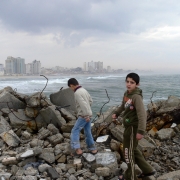HotSpots H2O: Longstanding Drought in Iran Begets Farmer Protests, Power Outages, and Widespread Water Rationing

Shahdad Desert, Iran. Photo © Mostafa Farzan
Christian Thorsberg, Circle of Blue
Lack of water is one of Iran’s biggest environmental and social risks. On the outskirts of Tehran, and in the country’s rural expanses, the signs of such stress are abundantly visible: brittle plains, cracked ground, sinkholes, sandy plateaus.
A decades-long drought in one of the warming world’s most arid regions, heightened by what many consider to be governmental mismanagement, has set the stage for a severe, dangerously dry 2021. The National Water and Wastewater Engineering Company of Iran warned this month that at least 210 cities will face water shortages in the summer. Over 7,000 rural districts will require the delivery of potable water via tanker trucks and other services. Many more communities are likely to be added to this list, and populous areas will be forced to ration water, said Hamid Reza Janbaz, the deputy adviser for water and soil in the Ministry of Agriculture Jihad.
Recent months have been uncommonly dry. Since late 2020, Iran has received only four inches of rain, 40 percent less than the nation’s long-term average. “From December 21, 2020, up to March 20, 2021, we had our worst period in terms of rainfall in the past 52 years,” Ghasem Taghizadeh Khamesi said in April. “We might even experience the worst drought in our history this year.”
In the Middle East, 85 percent of water is used for agriculture and irrigation. Not unlike the challenges experienced in other parts of the world, inconsistent precipitation, record-breaking high temperatures, and pronounced evaporation have made farming in Iran a variable, difficult livelihood, especially in the last year. The agricultural sector lost $2.79 billion and farmers held over 91 protests and demonstrations to voice their anger. They say the national government has not done enough to reconcile the losses and hardships faced by those who depend on a depleting resource.
“When there are no alternative jobs for those hit by the water shortages, and the government is unable to take back water and land rights granted to farmers, we will obviously witness more joblessness, discontent, friction, and confrontation,” Kaveh Madani, a Yale Senior Fellow and former Deputy Head of Iran’s Department of Environment, told the Center for Human Rights in Iran.
Excessive groundwater collection via illegal wells, by those desperate for water, has further strained Iran’s fragile landscape. Fueling a level of distrust, the government has attempted to paint the protesters as threats to national security, and as primitive water-warring people.
But the reality is that nearly all of Iran is experiencing, or soon will, water uncertainty. Iran International reports that 25 percent of Iran’s power generation relies on hydroelectric output. This year, amidst the water shortages, these dams are less than half full. Hours of power cuts, at schools and hospitals, have been reported as a result, compounding the difficulties of the pandemic. The interconnectedness of water and energy, economy and the freedoms of political demonstration, are being pressed upon by a relentlessly changing climate.
Christian Thorsberg is an environmental writer from Chicago. He is passionate about climate and cultural phenomena that often appear slow or invisible, and he examines these themes in his journalism, poetry, and fiction.











Leave a Reply
Want to join the discussion?Feel free to contribute!